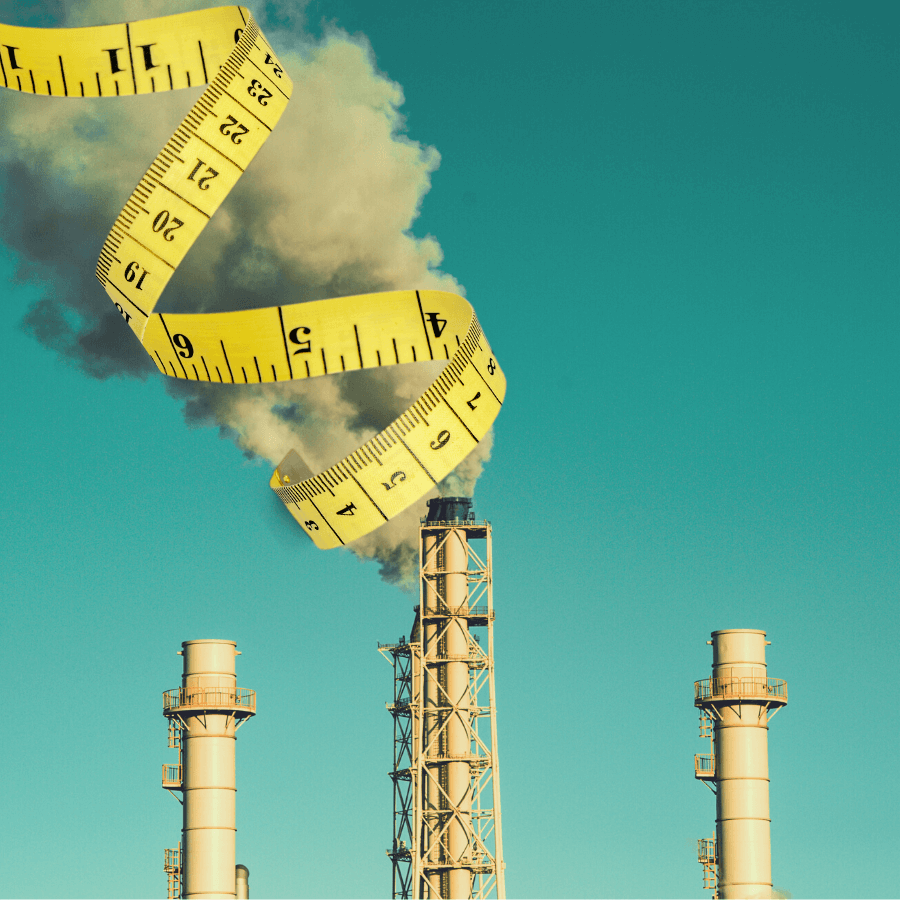This year, Corporate Knights set out to identify global companies that have decarbonized faster than their peers while simultaneously increasing revenue.
Our researchers evaluated the greenhouse gas (GHG) emissions of more than 6,500 publicly traded companies. We eventually whittled the list down to 20 corporations from eight sectors that cut the most carbon over the last decade.
Some of the companies on the list surprised us. Many are far from sustainability leaders. They’re among the world’s largest oil majors, coal burners and mining corporations. Though to be frank, in order to cut the most carbon, you have to emit enormous amounts of carbon to begin with.
As a group, over the course of the past decade (2012 to 2021) these 20 companies slashed their net GHG emissions (Scope 1 and 2) by 43%, from 862 million tonnes to 489 million tonnes. That also means that these companies have significant work left to do, as they still collectively emitted 489 million tonnes of GHGs in 2021, and they remain among the largest polluters on the planet. Yet the pace and scale of their reductions is in the realm of what every company and country must do by 2030 to keep the faith of the Paris Agreement.
But not all GHG reductions are equal. About two-thirds of the GHG reductions achieved by these companies were genuine from the planet’s perspective; much of it came courtesy of efficiency measures or retiring polluting assets. But 40% of the reductions came from divesting, or selling off, dirty assets, which from the atmosphere’s perspective is akin to rearranging deck chairs on the Titanic. For instance, 87% of oil giant BP’s 36.5-million-tonne gross GHG reduction came from divestment, according to the company’s submissions to the CDP, an international non-profit that runs a system where companies can voluntarily disclose their environmental impacts.
Italian electricity and gas distributor Enel topped the Carbon Reduction 20 ranking, cutting its Scope 1 and 2 emissions by 73 million tonnes since 2012 while doubling its market value. To boot, Enel managed to deflate its carbon bubble almost exclusively by retiring high-carbon assets. Most of these reductions were made from 2015 to 2021 when Enel shut down some 40 of its 50 coal power plants fast and furiously (from 31% of generation capacity to 6%). During this period, it bet the farm on renewables (wind and solar) and grid modernization, building some 70 renewable power plants in 2021 alone.
More controversially, it also increased energy production from natural gas. However, Enel plans to phase out the fossil fuel by 2040.
Not surprisingly, the company that took the second biggest chunk of carbon off its ledger was also a large power company, American Electric Power, which wound down most of its coal. But the company took a more plodding approach to coal, reducing it from 71% of its capacity to 55% while bumping up renewables (from 1% to 8%) and replacing the lion’s share of the hole left from the coal window by doubling its nuclear (from 11% to 22% of capacity).
Follow the money
The best way to tell the future of a company is to follow the money by looking at the investments it’s making today. On this score, you would expect to find that leading companies were investing the majority of new investments into growing their low-carbon business offerings.
That is not what we found, which is partially a function of opaque reporting by companies. According to calculations by Corporate Knights, these 20 companies funnelled just 35% of new investments in 2021 toward the sustainable, low-carbon economy, as defined by the Corporate Knights Sustainable Economy Taxonomy. While some investments are neutral (deemed neither “clean” nor “dirty”), in many cases these companies are still investing most of their capital into assets that will either lock in further GHG emissions or become stranded assets as the energy transition takes shape.
In terms of sustainable capital expenditures, as a whole the 20 companies projected total sustainable investments of $528 billion (all figures in U.S. dollars) through 2030. Enel (with $158 billion) and Spanish utility Iberdrola ($144 billion) led the way, directing 85% of their 2021 investments toward renewable low-carbon electricity systems. Whereas just 2.7% of Shell’s investments were classified as sustainable (a far cry from the 50% by 2025 target it has set for itself).
Interestingly, oil and gas company TotalEnergies has set aside $58 billion ($2.9 billion in 2021) for low-carbon sustainable investments by the end of the decade.
We also wanted to get a sense of the size of the Carbon 20’s clean investments compared to the amount of funds they paid out to shareholders (through dividends and buybacks), as well as top executive compensation. In an all-out race to zero emissions, you would expect companies to be directing the majority of their cash flow to solutions instead of shareholders and executives. But even among the largest reducers on the planet, that was not the case: 12 of the 20 funnelled more cash to shareholders and top executives than to growing their low-carbon sustainable business offerings.
However, there was a wide range among oil companies. Shell was at the bottom of the list with a 7.4% ratio, paying out $9.4 billion to shareholders and executives versus just $700 million to growing its low-carbon business. Meanwhile, its peers – TotalEnergies (28%), BP (29%) and Eni (59%) – invested significantly more into expanding their low-carbon solutions.
This suggests that (with some notable exceptions among industrial and power companies) we may need to look beyond the biggest carbon cutters to speed up the pace of climate-solutions deployment.
The U.S. civil rights activist Eldridge Cleaver once said, “There is no more neutrality in the world. You either have to be part of the solution, or you’re going to be part of the problem.”
Note that we didn’t include Scope 3 emissions (all of the indirect emissions within a company’s value chain) as the data was often incomplete and unreliable for the 10-year period we looked at. We hope that in the near future, we’ll be able to do a year-over-year analysis that includes Scope 3 emissions.
The revenue-increase requirement for the Carbon Reduction 20 was not applied to oil and gas companies, as the transition to a low-carbon economy requires that oil and gas be phased out. Read the report’s full methodology.
| Rank | Company | Sector | 2021 GHG Emisisons (tCO2e) | GHG Reduction 2012–2021 (tCO2e) | Percentage Change | Revenue change 2012–2021 (%) | How GHG Reductions Were Achieved: | |
|---|---|---|---|---|---|---|---|---|
| 1 | Enel SpA | Power | 55,873,449 | 73,068,149 | -57% | 1% | Retirements (89%) Divestments (8%) Energy efficiency (3%) | |
| 2 | American Electric Power Company Inc | Power | 56,719,856 | 65,207,544 | -53% | 12% | Retirements and divestments (100%) | |
| 3 | Électricité de France SA | Power | 27,670,022 | 52,687,538 | -66% | 17% | Retirements (54%) Divestments (25%) Energy efficiency (12%) Other (9%) | |
| 4 | BP PLC | Oil & Gas | 35,600,000 | 32,600,000 | -48% | -58% | Divestments (87%) Energy efficiency (12%) Retirements (1%) | |
| 5 | Iberdrola SA | Power | 15,340,932 | 27,309,461 | -64% | 14% | Energy efficiency (42%) Retirements (36%) Divestments (3%) Other (19%) | |
| 6 | Exelon Corp* | Power | 13,720,187 | 18,010,245 | -57% | 41% | Divestments (94%) Enregy efficiency (4%) Retirements (2%) | |
| 7 | TotalEnergies SE | Oil & Gas | 35,374,000 | 16,026,000 | -31% | -21% | Energy efficiency (80%) Divestments (5%) Others (15%) | |
| 8 | TransAlta Corp | Power | 12,505,733 | 14,061,549 | -53% | 23% | Retirements (97%) Energy efficiency (3%) Divestment (1%) | |
| 9 | Rio Tinto Ltd | Metals & Mining | 30,000,000 | 13,300,000 | -31% | 25% | Divestments (59%) Energy efficiency (41%) | |
| 10 | Eni SpA | Oil & Gas | 40,889,292 | 12,455,791 | -23% | -39% | Energy efficiency (91%) Others (9%) | |
| 11 | Shell PLC | Oil & Gas | 69,000,000 | 12,000,000 | -15% | -44% | Divestments (55%) Other (45%) | |
| 12 | Xcel Energy Inc | Power | 44,650,000 | 11,012,439 | -20% | 33% | Retirements (78%) Other (22%) | |
| 13 | Compagnie de Saint-Gobain SA | Industrials | 10,330,210 | 7,020,790 | -40% | 2% | Energy efficiency (51%) Retirements (30%) Divestments (19%) | |
| 14 | Vale SA | Metals & Mining | 11,052,225 | 6,820,776 | -38% | 222% | Divestments (39%) Energy efficiency (25%) Other (37%) | |
| 15 | Solvay SA | Industrials | 11,224,000 | 3,682,654 | -25% | 5% | Energy efficiency (53%) Divestments (47%) Retirements (0.1%) | |
| 16 | Koninklijke DSM NV | Industrials | 1,200,000 | 3,000,000 | -71% | 7% | Divestments (84%) Energy efficiency (16%) | |
| 17 | Republic Services Inc | Waste | 13,862,083 | 2,200,930 | -14% | 39% | Energy efficiency (100%) | |
| 18 | Weyerhaeuser Co | Agriculture & Forestry | 932,693 | 1,736,587 | -65% | 70% | Divestments (73%) Energy efficiency (10%) Others (17%) | |
| 19 | Canadian Pacific Railway Ltd | Transportation | 2,991,189 | 493,166 | -14% | 40% | Energy efficiency (91%) Divestments (9%) | |
| 20 | Simon Property Group Inc | Buildings | 196,822 | 321,038 | -62% | 20% | Energy efficiency (100%) |
Source: Corporate Knights, CDP
Note: percentages for “How GHG reductions were achieved” may not add up to 100% due to rounding.
N/A: Not disclosed
Energy efficiency includes measures such as reducing flaring, reducing fugitive emissions, use of renewable energy to replace fossil fuel-based sources, recycling and landfill-gas-to-energy projects in the case of waste management activities amongst others
Others include items such as change in output, change in methodology, change in boundaries, change in physical operating conditions, temporary shutdowns and reactivations, acquisitions, and other unidentified causes
* 2020
Top Company Profile
How one company cut more carbon than any other on the planet
BY Naomi Buck
How Europe’s largest utility managed to shrink emissions by more than half over the last decade while growing



